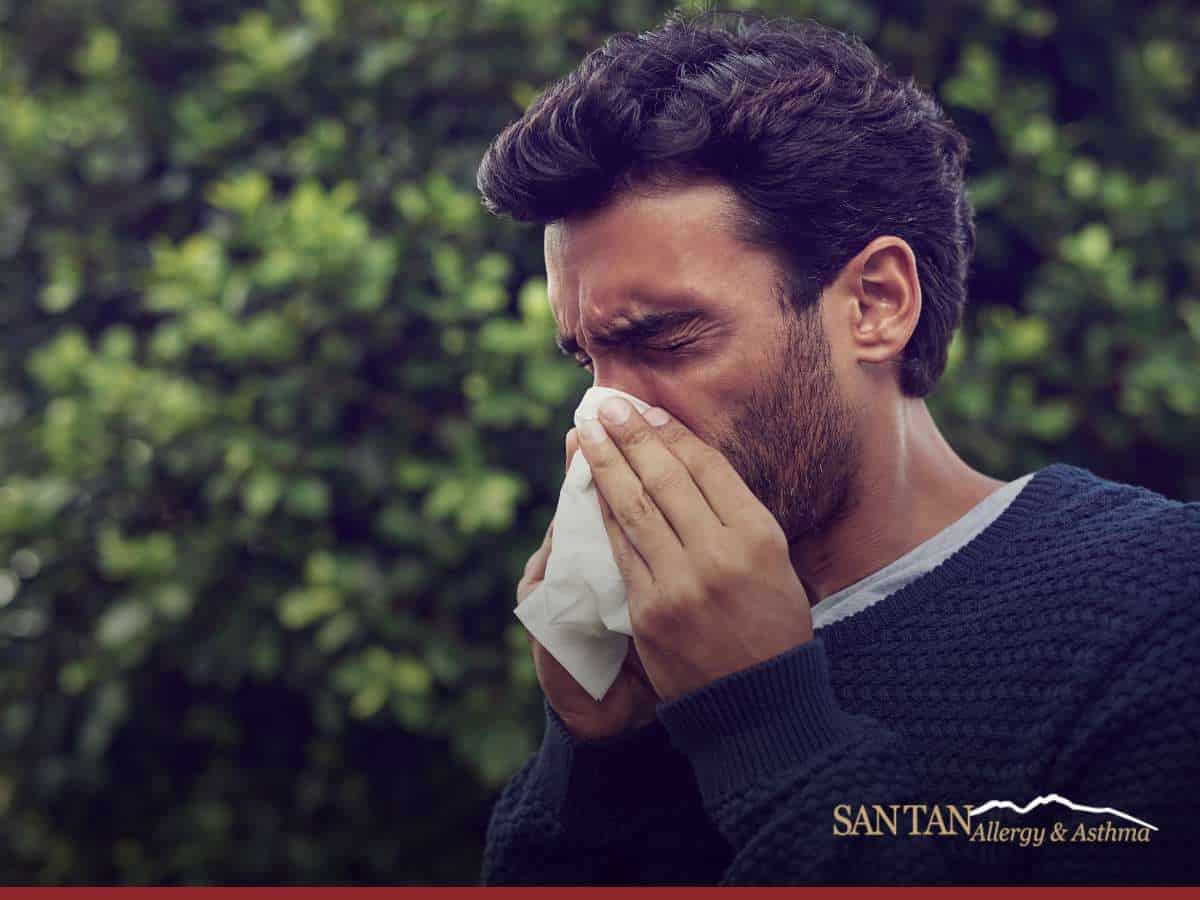How Rain and Humidity Affect Allergies: Tips To Reduce Symptoms
Arizona’s monsoon season can bring real relief for many people. After all, the rain often feels like a welcome break from long weeks of dry, hot weather. With the earth dampened, there’s a refreshing sensation in the air. But what about those who suffer from allergies? Environmental triggers can negatively affect some individuals, setting off those all-too-familiar and bothersome sneezing fits.
But that’s not all. In more severe cases, asthma symptoms may also worsen. This is why it’s important to understand how rain and humidity can impact people with allergies. By doing so, it becomes much easier to take steps that reduce or mitigate the effects. That’s exactly what we’ll explore throughout this article!

Why Rain Can Make Allergies Worse
It might seem counterintuitive that rainfall, which washes dust and pollen from the air, can also worsen allergy symptoms. The answer lies in the way water interacts with pollen grains.
Pollen particles are coated with a strong outer shell that protects the proteins inside. When raindrops strike these grains, the sudden burst of moisture causes them to break open. The proteins, now exposed and airborne, spread quickly, especially when carried by wind after a storm. This process significantly increases the concentration of allergens in the air, leading to flare-ups for people with seasonal sensitivities.
In fact, according to the CDC’s National Center for Health Statistics, nearly 1 in 3 U.S. adults and more than 1 in 4 children reported having a seasonal allergy, eczema, or food allergy. About one quarter (25.7%) of adults experience seasonal allergies, which means that weather shifts like rainfall can affect a large portion of the population. This widespread prevalence highlights why storm-related allergy spikes are such a serious public health concern.
This phenomenon explains why many people report sudden congestion, sneezing, or even asthma attacks shortly after thunderstorms. For those experiencing wheezing or difficulty breathing during storms, respiratory testing and treatment may be necessary to assess lung function and manage symptoms properly.
Common Monsoon Triggers During Monsoon Season
Different allergens behave in distinct ways during monsoon season. Identifying the most common triggers can help you predict and manage potential reactions, and consulting with experienced allergists can provide valuable guidance on how to reduce your risks. Through environmental allergy testing, our team at San Tan Allergy & Asthma can help pinpoint whether mould, pollen, or dust mites are causing your symptoms.
1. Mould Growth
High humidity creates the perfect breeding ground for mould. These fungi release spores into the air that can cause nasal congestion, watery eyes, and coughing. Damp areas inside the home, such as bathrooms and basements, often make symptoms worse.
2. Dust Mites
Dust mites thrive in warm, humid environments. They feed on shed human skin cells and are commonly found in bedding, carpets, and upholstery. Their presence is a leading cause of allergic rhinitis and can increase the risk of asthma flare-ups.
3. Grass & Weed Pollen
While tree pollen tends to peak during drier months, grasses and weeds become problematic during the rainy season. Moisture from rain breaks down pollen clusters into smaller, more easily inhaled particles, amplifying allergic responses.
4. Pet Dander
Pets that spend time outdoors during monsoon months often carry mould spores and pollen back indoors. For sensitive individuals, this can mean increased symptoms after cuddling with a beloved dog or cat.
Common Monsoon Allergy Symptoms To Watch For This Season
Monsoon-related allergic reactions can vary in intensity, depending on the specific trigger and the individual’s overall health. While some people may only experience mild discomfort, others can face symptoms serious enough to disrupt daily routines. Recognizing these early signs is essential for seeking timely allergy relief and preventing more severe complications:
- Persistent sneezing and runny nose: Often caused by sudden bursts of pollen proteins or mould spores in the air, this is one of the earliest and most noticeable reactions.
- Nasal congestion or sinus pressure: Swelling of nasal passages can make breathing difficult and may lead to headaches or facial pain, especially if sinus infections develop.
- Red, itchy, or watery eyes: Irritation of the eyes is common during high humidity when airborne allergens linger and come into direct contact with sensitive tissues.
- Coughing or wheezing: These symptoms may indicate that allergens have traveled deeper into the airways, triggering inflammation and irritation.
- Skin rashes or hives: Direct contact with mould, dust mites, or even pet dander carried indoors during the rainy season can cause itchy, red patches on the skin.
For people already dealing with chronic respiratory conditions or weakened immune systems, these symptoms can escalate quickly!
The Link Between Monsoon & Asthma
For individuals with asthma, the monsoon season can be especially challenging. The combination of increased mould spores, dust mites, and airborne pollen proteins heightens airway inflammation.
Thunderstorm asthma, a well-documented phenomenon, occurs when storm activity causes sudden spikes in airborne allergens. The strong winds and rapid changes in humidity during storms can carry pollen particles deep into the lungs, triggering asthma attacks.
According to the Asthma and Allergy Foundation of America (AAFA), over 28 million people in the U.S. live with asthma, which makes these weather-related triggers a serious concern. This reality highlights the importance of staying alert!
How To Minimize Exposure Indoors
While avoiding allergens entirely is impossible, creating a cleaner indoor environment can significantly reduce symptoms. Consulting an allergy expert can help tailor these strategies to your specific triggers and make your indoor space safer during monsoon season.
- Control Humidity: Use a dehumidifier or air conditioner to keep indoor humidity levels below 50%. This prevents mould and dust mites from thriving.
- Frequent Cleaning: Wash bedding in hot water, vacuum carpets with HEPA filters, and wipe down damp surfaces to limit allergen buildup.
- Air Circulation: Good ventilation helps reduce indoor allergen concentration. Use exhaust fans in kitchens and bathrooms.
Together, these measures create a healthier indoor environment and reduce the likelihood of severe allergy flare-ups during the rainy season.
Outdoor Tips To Prevent Allergy Exposure
It’s not always possible to stay indoors during monsoon season, but certain strategies can help lower the risk of exposure:
- Avoid going outside right after heavy rainfall, when pollen proteins are most concentrated.
- Wear a mask on high pollen or windy days.
- Shower and change clothes after spending time outdoors to prevent allergens from lingering on your skin and hair.
- Keep windows closed during thunderstorms to reduce the entry of spores and pollen particles.
By following these precautions, you can continue to enjoy outdoor activities while minimizing exposure to the most common monsoon triggers.
Medical Support & Treatments For Monsoon Season Relief
Self-care and preventive measures go a long way, but some cases require professional evaluation. An allergy expert can help identify the specific triggers responsible for your symptoms and recommend personalized treatment options.
For example, an allergy test can determine whether mould, dust mites, or pollen are the main culprits. Once identified, targeted therapies, such as antihistamines, nasal sprays, or immunotherapy, can provide long-term relief.
For individuals with asthma, consulting a doctor is critical. These specialists can adjust medication plans, suggest inhaler use, and teach strategies for managing flare-ups during storm-heavy months.
In cases of severe symptoms, especially when normal breathing is affected, immediate medical attention should be sought.
Strengthening Your Immune System
While avoiding allergens is key, building resilience through overall wellness is equally important. A balanced diet rich in fruits, vegetables, and whole grains supports a healthy immune response. Staying hydrated helps clear mucus and flush irritants from your system.
Regular exercise, when done indoors away from allergens, also improves lung capacity and strengthens overall health.
Take Control Of Your Health Today With Professional Help
If monsoon allergies or asthma are disrupting your daily life, it’s best not to wait until symptoms worsen. At San Tan Allergy & Asthma, our specialists are here to help you find lasting relief. Schedule a consultation today and take the first step toward breathing easier this monsoon season.
Our team of allergy doctors in Gilbert is ready to provide comprehensive testing, personalized treatment plans, and ongoing support to help you breathe easier this season. Contact us today!







